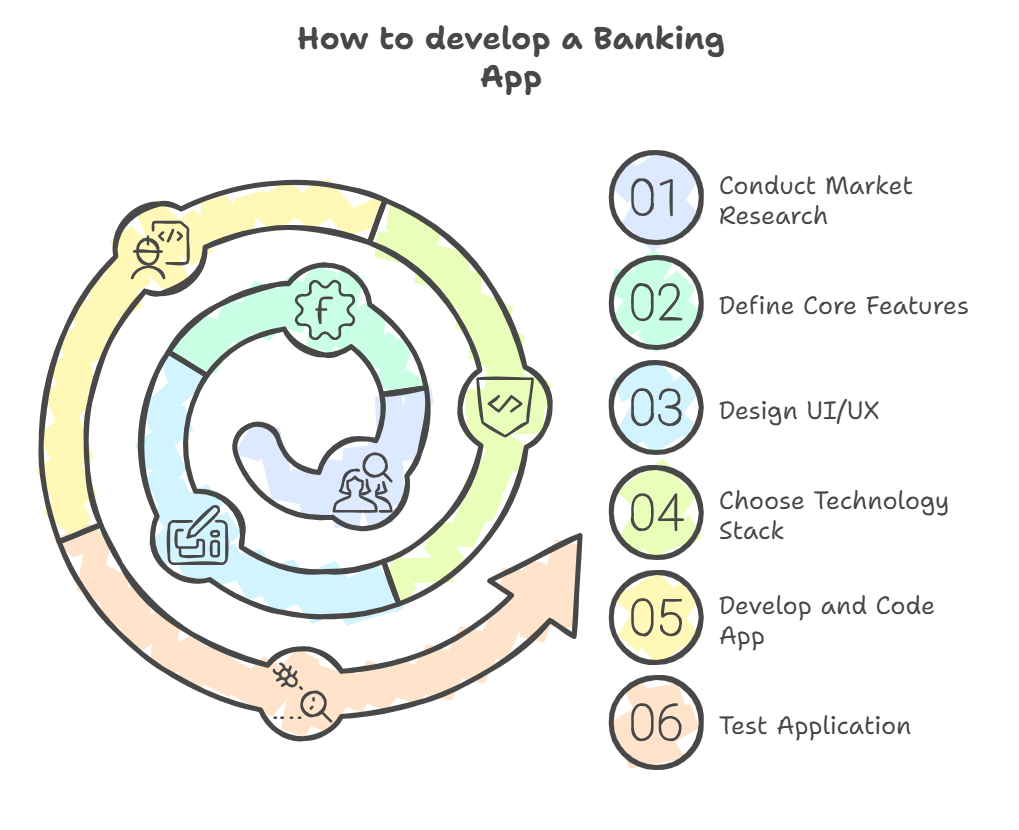How much does it cost to develop a mobile banking app? This question often arises for businesses looking to tap into the growing fintech market. With millions of users relying on mobile apps for their banking needs, the demand for secure, user-friendly, and feature-rich solutions has skyrocketed. In this guide, we’ll discuss the key factors that influence mobile banking app development costs, from core features and platform choices to compliance requirements and team size. Let’s break down the core aspects and uncover how much investment it takes to create an outstanding mobile banking app.

Mobile banking market overview
The mobile banking sector has seen noticeable growth in recent years, driven by technological advancements and a rising demand for convenient financial services. In 2023, the global mobile banking market was valued at approximately $1.7 billion and is projected to reach $8.3 billion by 2032, reflecting a compound annual growth rate (CAGR) of 19.27% statistics show. This growth highlights the rising reliance on smartphones as a primary channel for banking activities.
In the United States, mobile banking usage among bank account holders has steadily increased. As of the third quarter of 2024, 63% of U.S. bank account holders processed their banking matters via mobile devices, up from 58% in the first half of 2019 according to Statista. Here is a financial industry trends overview for mobile banking:
- With rising cyber threats, advanced security features like two-factor authentication, encryption, and biometric access are now standard in app development.
- AI-driven features like personalized insights and predictive analytics are becoming more important for improving user engagement.
- Mobile banking apps are playing an important role in bringing banking services to underserved regions, and fostering financial inclusion.
- Mobile banking apps are increasingly integrating features like insurance services, enabling users to purchase, manage, and claim insurance policies directly through their banking platform.
The competitive nature of the market is pushing banks and fintech companies to innovate continually. Features like QR code payments, in-app financial planners, and voice-activated banking are increasingly expected by users. As the future of AI in banking and insurance continues to shape the industry, integrating AI-driven solutions for personalized experience and fraud detection is becoming an important factor for staying competitive. As a result, institutions that fail to adapt risk losing market share to more agile competitors. Companies entering this space must prioritize innovation, user experience, and security to meet rising expectations and stay ahead.
Factors that Influence mobile banking app development cost
The cost of development of a mobile banking app depends on various factors that collectively determine the overall investment required. These factors range from the complexity of features to the geographical location of your development team. Below is a detailed breakdown of the key features your fintech product needs that influence mobile banking app development costs.
Features and functionalities
Basic functionalities such as account management, transaction processing, and push notifications form the foundation of a mobile banking app. These typically account for $30,000–$70,000 in development costs. AI-powered financial insights, predictive analytics, and blockchain integration can greatly improve user experience but elevate costs to $100,000 or more, depending on their complexity.
Incorporating best practices for banking app design, such as intuitive navigation, responsive layouts, and accessibility features, creates a seamless user experience while meeting diverse customer needs. Features like multi-factor authentication, biometric login, and real-time fraud detection are necessary for financial apps, often adding $10,000–$20,000 to the cost of developing a banking app.
Platform choice
Native development, which involves creating separate apps for iOS and Android, delivers superior performance and user experience for each platform. However, this approach requires more time and resources, with costs typically exceeding $100,000 per platform. Alternatively, cross-platform development, using frameworks like React Native or Flutter, allows developers to reuse a single codebase across platforms, reducing costs to $50,000–$100,000. While this method is more budget-friendly and expedites development, it may not match the seamless performance of native apps in certain scenarios.
Development team size and expertise
A full in-house team grants direct control over the development process and fosters seamless communication that aligns with business goals. However, this option involves higher operational expenses, typically between $150,000 and $250,000 for a medium-sized app. Businesses may outsource projects to development firms in cost-effective regions like Eastern Europe or Asia, reducing the cost of developing a banking app to $80,000–$150,000 while preserving high-quality output. This strategy also gives access to a global talent pool and adds flexibility and scalability without diminishing results.
Compliance and regulatory requirements
Compliance and regulatory requirements remain important in mobile banking app development, as they protect user data and support legal mandates across regions. When teams meet industry standards such as GDPR, PCI DSS, and PSD2, they integrate secure APIs, encryption protocols, and advanced authentication measures. This approach increases the development budget by $10,000–$30,000. Teams also schedule regular audits and updates, so the app stays aligned with regulations that frequently change, leading to ongoing compliance expenses.
Marketing, launch, and updates
Promoting the app through social media, ads, and partnerships adds $10,000–$50,000, which depends on the scale of the campaign. Regular updates to address bugs, add new features, and comply with changing regulations require ongoing investment. Annual maintenance costs typically range from $10,000–$30,000.
Cost estimates for different complexity levels
When planning the development of a mobile banking app, you need to understand the fintech app development cost implications of various complexity levels. From simple apps with core features to advanced solutions packed with the best functionalities, the development cost depends heavily on the scope of features, platform selection, and team structure. Below is a detailed cost breakdown to guide your decision-making process.
| App Complexity | Features Included | Estimated Cost Range | Development Time |
| Simple App | Basic account management, transaction history, fund transfers, and basic security | $25,000 – $50,000 | 3-6 months |
| Moderate App | Features from the simple app plus bill payments, notifications, and reliable security | $50,000 – $100,000 | 6-9 months |
| Advanced App | All features from moderate apps, AI integration, investment tools, P2P payments | $100,000 – $150,000 | 9-12 months |
| Highly Complex App | Advanced app features plus blockchain, multi-layered security, and bespoke integrations | $150,000 – $300,000+ | 12+ months |
Your budget remains optimized when you define your app’s objectives and choose features that match user needs. You begin with a minimum viable product (MVP) and validate your idea. You expand functionality as your app gains traction. With a clear plan, a well-chosen team, and strategic decisions, you build an app that balances cost and quality and provides long-term success.
How to develop a banking app
When you build a banking app, you must adopt a structured approach that combines innovation with security and usability. Because financial technology is increasingly part of everyday life, users now expect seamless, feature-rich experiences that emphasize convenience and data protection. Each step in the development process influences the creation of an advanced, reliable mobile banking solution. Below is a guide that helps you to develop a high-performing banking app.

Source: napkin.ai
Step 1. Conduct market research
Begin with an analysis of your target audience, competitor offerings, and industry trends. Understand user needs and market gaps to define your app’s unique value proposition. Identify key features that users demand, such as strong security, easy access, and personalization. Also, review regulatory requirements like GDPR or PCI-DSS so you comply from the start.
Step 2. Define the core features
Prioritize basic features for your banking app, such as account management, transaction history, and secure fund transfers. Once the core functionalities are identified, consider advanced options like AI-driven insights, biometric authentication, or P2P payments. Start with a Minimum Viable Product (MVP) that includes only core features, allowing you to launch faster and refine the app based on user feedback.
Step 3. Design the user interface (UI) and user experience (UX)
A seamless and intuitive design is important for retaining users and engagement. Develop wireframes and prototypes to visualize the app’s layout and navigation flow. Focus on creating a user-friendly interface with simple navigation, responsive design, and customizable options to cater to diverse user preferences. Testing these designs with potential users will make the app intuitive and accessible.
Step 4. Choose the technology stack
Selecting the right technology stack makes your app scalable, secure, and compatible with the target platforms. For mobile banking apps, consider frameworks like Flutter or React Native for cross-platform development, and back-end technologies such as Node.js or Django. Cloud platforms like AWS or Google Cloud improve scalability and reduce infrastructure costs.
Step 5. Develop and code the app
With the designs and technology stack in place, begin the development process. Backend developers work on the server-side logic, databases, and APIs, while frontend developers implement the user interface and provide responsiveness across devices. Security measures, such as encryption, multi-factor authentication, and secure APIs, should be integrated throughout the development phase to protect sensitive user data.
Step 6. Test the Application Thoroughly
Testing is necessary to identify and fix bugs before the app is launched. Conduct functional, usability, performance, and security tests on various devices and operating systems to provide reliability and compliance with industry standards. Automated tools like Appium or Selenium can expedite the testing process, while manual testing helps uncover edge-case issues.
Step 7. Launch and deploy the app
After the app passes thorough tests, the next step is to deploy. Submit it to the relevant app stores and follow platform-specific guidelines to avoid approval delays. A phased or beta release can be a strategic way to collect real-world user feedback. This approach lets developers refine features and correct overlooked issues before a broader launch. Along with the launch, teams prepare well-written documents for users and administrators and offer accessible support channels for questions or technical problems.
Step 8. Monitor, maintain, and update
App development doesn’t end with the launch. Regularly monitor performance metrics and user reviews to identify areas for improvement. Release updates to introduce new features, address bugs and maintain security compliance. Continuous maintenance helps the app to follow mobile app trends and remain relevant and competitive.
Building a mobile banking app is a multifaceted process that demands attention to detail, a user-first mindset, and alignment with industry standards. A well-defined development framework starts with market research and ends with post-launch maintenance. You must emphasize security, usability, and scalability to deliver long-term value and maintain user trust.
Conclusion
Investing in a mobile banking app is more than a financial commitment—it is a step toward delivering convenience, security, and innovation to your users. With proper planning and execution, you can create an app that meets industry demands and positions your business for long-term growth. We hope our article has provided you with a clear breakdown of the costs associated with developing a mobile banking app. From simple apps with basic features to highly complex solutions, the investment required depends on various factors like feature complexity, platform choice, team size, and regulatory compliance.
FAQ
What is the average fintech app development cost?
The cost of developing a mobile banking app can range from $25,000 for a simple app with basic features to over $300,000 for highly complex apps with advanced functionalities like AI integration and blockchain. Factors such as team location, technology stack, and compliance requirements play a big role in determining the final cost.
Is outsourcing development to other regions cost-effective?
Outsourcing to regions like Eastern Europe or Asia can reduce development costs by 30-50% compared to hiring in-house teams in Western countries. It also provides access to experienced developers while maintaining quality standards. Outsourcing offers flexibility in scaling the team based on project requirements and allows businesses to focus on core operations while delegating technical tasks to skilled professionals.
What are some examples of successful mobile banking apps and their features?
Apps like Revolut, Chime, and Monobank are prime examples of successful mobile banking solutions. They offer features like seamless fund transfers, expense tracking, budgeting tools, and AI-driven insights. Studying these apps can help identify features and functionalities that align with your target audience.























Leave a comment!